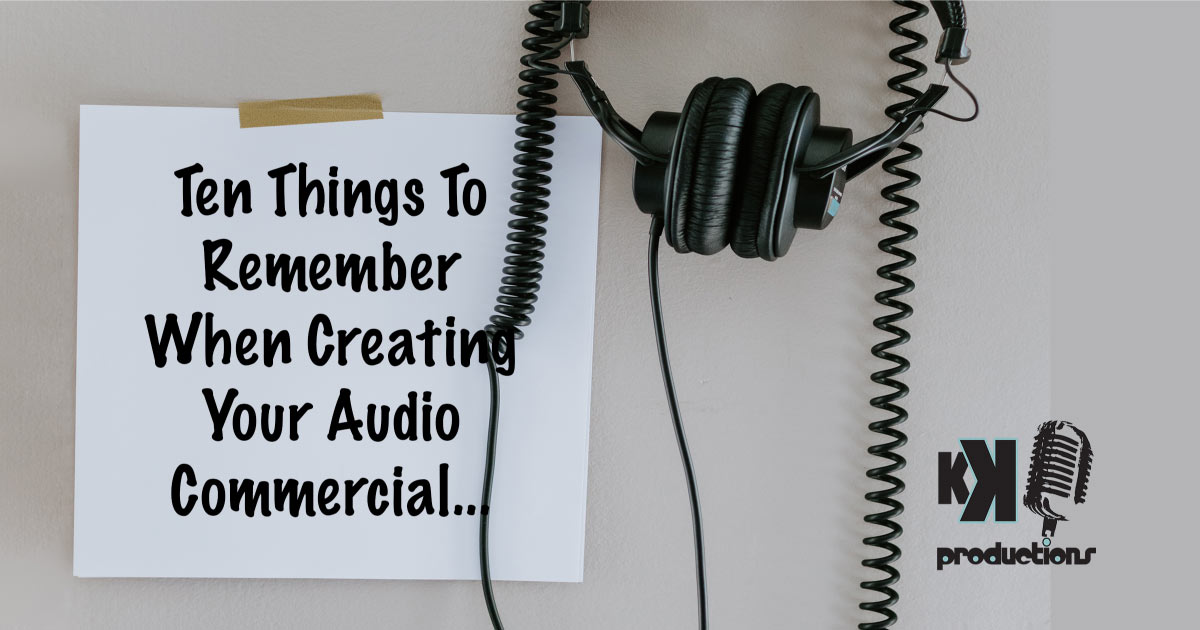I’ve done hours and hours of research on”how to create effective radio spots ” that are creative, memorable and stand out. And if you’ve been doing this long enough, you know that on the top of that list is a great script. I mean if it works for television, movies and film, then it should work for your thirty or sixty second spot.
But, unfortunately, we find ourselves beholden to a client who wants their kid, spouse or mother-in-law to voice their spot that includes a laundry list of detailed information and a phone number that nobody will remember. And of course, they want this wasted time to run on their favorite radio station that in no way reflects their business demographic. But they love the on-air personality and they just have to hear their commercial on that station.
Does any of this sound familiar?
Below are a few tips on how to educate your client on the”Why ” behind creative, as well as simple things to keep in mind when writing copy, and what not to put in your audio spots. These tips and suggestions are designed to help you write and produce audio spots that are creative, effective and memorable, and to help navigate your way when dealing with a client who thinks they know better.
But first, a couple things to keep in mind:
Consider the business model of radio or streaming audio: Regardless of whether it’s terrestrial or streaming, any commercial audio product relies on programming, production, and promotions to execute, and hopefully garner millions of listeners and great ratings. In order to keep these properties afloat, they need sponsors, advertisers and a team of highly skilled sales people. The successful results of ratings, listenership and overall support of these audio entities are given to clients, sponsors and potential advertisers via sales. Clients pay to share in this process, and are more likely to advertise if people are listening.
Think about what a”broadcast hour ” is filled with; there’s music or some form of programming, promotions and advertising. The advertising portion is the percentage that most listeners ignore, but it’s most important to sales and their clients, and in some respects, they are responsible for making sure this percentage of the hour (and every hour) doesn’t lose listeners.
Consider how the commercial percentage of a broadcast affects the overall product and performance of the radio station or streaming service. It’s pretty simple really-
- Bad or off-putting commercials = fleeing listeners. They just dirty up the airwaves! Consider that What the client’s ads have to say, is as important as what they pay.
By holding your client accountable for their portion of the broadcast, you will better control the creative, and the outcome. The ten tips below will help too!
- Commercials should grab anybody’s attention. Not just the listener you’re trying to reach. Example: If your spot starts with”Attention Carpenters “, you can say goodbye to the majority of your audience that are NOT carpenters. You should be capturing anyone’s interest until you can make a case for the carpenters. The goal: Get your audience to stay with the spot, so they can alert the carpenters about what they heard.
- Efficiency – Trimming the copy to its leanest manifestation. A thirty-second spot is twice as hard to write as a sixty. That’s half the time to make your point. Repeating the call to action, price points or web address is fine, but to achieve an efficient script that is creative, tells a story and can engage while keeping the point relevant and simple to understand is better. Remember, your job is to drive the listener to an action. It’s up to the client to sell them, not your thirty second spot.
- Give the listeners the benefit of the doubt. Instead of”Saturday Night, April 7th at 7:30 PM “, use”Next/This Saturday night at 7 ” or”Tomorrow Night at 7 ” or instead a long list of prices or specifics on a service, use bullet points and then direct the listener to”more details ” and a website that has them**. Unless the offer is so amazing that nobody would pass it up, KEEP IT SIMPLE, and LEAVE THEM WANTING TO KNOW MORE. (**Pet Peeve – make sure the website has all the details that you are alluding to in the commercial. So annoying.)
- Just because the client thinks his commercial is great, doesn’t mean it is. We have to speak up as experts in our field and hold our clients accountable by providing effective creative. Be the “GATE KEEPER” and “JUST SAY NO” to bad copy. It’s important to offer clients alternatives and solutions, but it’s equally important to educate them on the “WHY” behind the creative. Giving in to your clients 84 second spot that is all too wordy and ineffective, is not giving them the results they expect out of their advertising campaign. BE RESPONSIBLE FOR YOUR PERCENTAGE OF THE PROGRAMMING.
- Write like you speak. When writing audio copy, words need to be spoken convincingly. You should always read your copy out loud like you would naturally speak these words to someone you know. Words have to be heard to be persuasive. Avoid throw away and insulting words like “Don’t Forget” before you have even told them what they should remember in the first place. Eats up time and there’s no payoff. Speak real. Write real.
- There is no good reason for this! Most clients think that if you repeat the phone number enough times, their sales will increase. Well ask yourself this. If someone you’re not interested in comes up to you and gives you their phone number, and begs you to call, will you call? On the other hand, if someone is funny, charming and interesting and they get your attention, will you engage and find out more? Of course, you will! This is about creating interest. Grabbing their attention, leaving the listener wanting to know more. It’s not about the phone number, unless it’s 1 800 Chocolate! Remember, you’re peaking interest with relevancy, engagement and information. A phone number isn’t even necessary, and it takes up a lot of valuable time.
- Websites are your best friend. Rarely do businesses who advertise, not have a website. So unless a phone number is mandatory for tracking purposes, your call to action for the spot should always try to get the listener to the client’s website. So much can happen as a result. You have a better script, because you aren’t jamming everything the client offers into it. You have a better position to brand and entertain, and the client can state their case to any prospective customer on a website that they have most likely invested time and money into. Once you have the listener wanting more, then directing them to the place they can get the information they seek, results in a payoff for both client and listener. However, if you direct a listener to a website that doesn’t provide the information presented in the ad, your client has not only lost a potential customer, but your listener has lost their trust in your communication and that is not paying off for anyone!
- Know your client’s objective and how it relates to your audience. Is it strictly for branding purposes? Driving customers to a website, event or sale? What does your client expect to get out of their commercial? Knowing what success means to the client will determine how the spot or campaign is built and who you’re building it for. Targeting the right audience will help to develop key messages and identify the best way to communicate those messages. Delivering a creative and memorable message is key.
- So is perception! When conceptualizing creative for audio. Step outside the creative box (literally) and try and look at it from the perception of the listener. Ask the questions that they would ask, like”what’s in it for me? ” or”How will this make my life better? “. There are many different types of advertising styles when it comes to audio spots, but the common theme is to deliver impactful messaging to the listener that provides something that will answer those questions.
- You have one chance to grab the listener, and one chance only. Commercials can be disregarded immediately if you haven’t peaked a listener’s interest within the first few seconds of your spot. There are many ways you can do this, but knowing the overall objective will determine what that first five seconds sounds like. Get the listeners attention, peak their imagination or hit them with a”Wow ” factor, because if you don’t get them in the first five seconds, you won’t get them back. More on this in my blog”Off Script ” on the #1 Thing Every Radio Spot Needs to Be Successful.
The make-up of a great ad is relevant to the demographic it’s designed for so that it effectively connects to the target audience with simple, clear and creative messaging. This communication should be memorable and present a call to action and/or information that is easily accessed, like a website. But it also needs to”speak ” to a broad audience so that it doesn’t drive away listeners.
“TV gives everyone an image, but radio gives birth to a million images in a million brains. ” – Anonymous

